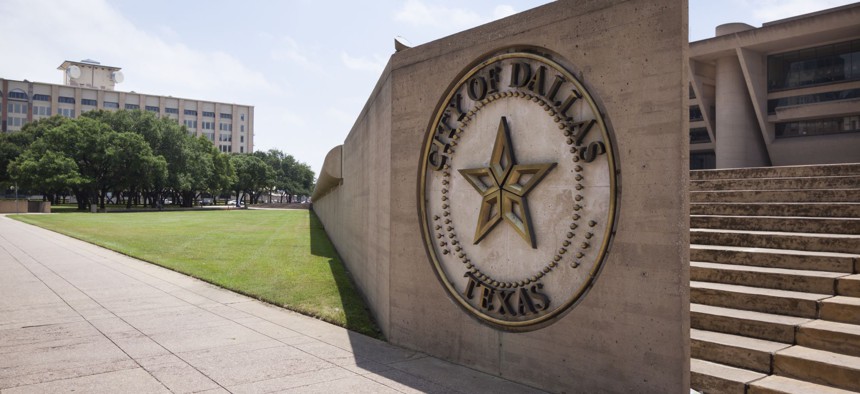In Booming Dallas, Bankruptcy Talk Shines Light on City’s Tough Fiscal Predicament

Dallas City Hall Shutterstock
Whatever comes next in the nation’s ninth-largest city, it won’t be pretty.
The current police and firefighter pensions crisis that’s been unfolding in Dallas hasn’t been a surprise to anyone watching local politics in the nation’s ninth-largest city or municipal finance around the U.S.
But national attention from The New York Times before Thanksgiving regarding a possible municipal bankruptcy has brought an unwanted—but also necessary spotlight—on the pressing “Texas-size” fiscal predicament Dallas City Hall finds itself in. No other U.S. city, aside from Chicago, faces such a difficult pension debt struggle.
“Dallas has a problem that could bring it to its knees,” The Times wrote.
Like all stories about troubled municipal pensions, what’s played out in Dallas is a complicated mess, something that’s been years in the making.
But the immediate crisis that’s been playing out over the course of six weeks or so, as Dallas retirees concerned with the fund’s investments have withdrawn $220 million out of the city’s police and fire pension fund, which now needs a one-time infusion of $1.1 billion from the city just to keep treading water.
That amount is roughly equal to the city’s general fund budget. And local officials have no way to pay that.
Doing so, Dallas Mayor Mike Rawlings told the Texas State Pension Review Board, would require a property tax hike of 130 percent, the Dallas Observer reported.
"Every single city property owner in the city of Dallas would be hugely impacted by this increase," the mayor said. "It's a ridiculous suggestion."
The third-largest city in Texas certainly isn’t alone when it comes to troubled municipal pensions. But the big problem in Dallas shows that a place with a booming economy isn’t immune from distressing fiscal entanglements.
Bloomberg View columnist Justin Fox recently profiled how Dallas anchors a metropolitan area that “has been, by just about every metric, the nation's job-creation leader.”
Dallas is not Detroit, nor is it Harrisburg, economically challenged places that have had to go down the road of bankruptcy.
And the city isn’t officially at the “b” word yet—Dallas is expected to lay out a plan for an overhaul next month and will seek some regulatory relief from Texas lawmakers in the new year. But the striking dichotomy of a booming economy and a possible municipal bankruptcy is nonetheless shocking and something that’s been noted by local leaders, including the mayor.
"It is horribly ironic that a city that has enjoyed such tremendous success, a city that has made Texas so strong and so proud is potentially walking into the fan blades that look like bankruptcy," Rawlings told the state pensions review board. "Shame on me, shame on you, shame on all of us if we allow that to happen."
The Times spotlighted the mayor’s sobering comments of his city “walking into the fan blades.”
Dallas Observer columnist Jim Schutze bristled a bit at the national attention:
Based on that article alone, the name of that newspaper could be changed to the Schadenfreude Bugle: “Dallas has the fastest economic growth of the nation’s 13 largest cities,” the Times story says in the setup. “Its streets hum with supersize cars, and its skyline bristles with cranes.”
You know the line: big cars, big hair, big cranes, big idiots. Then the gut-punch. Referring to our police and fire pension catastrophe, the Times story says “Dallas has a problem that could bring it to its knees …”
Big idiots with big hair getting out of their big cars and falling to their knees, bankrupt and el-bust-o all over town, to the delight of the smartpants nation. What a picture.
The Times’ feature on the Dallas fiscal mess spurred the editorial board of The Providence Journal in Rhode Island, a state that’s no stranger to state and local pensions problems, to ask:
How could Dallas, a low-tax business hub with the fastest economic growth of America’s 13 biggest cities, be going down the tubes?
For those who want to get a better explanation of the fiscal forces that are squeezing Dallas City Hall, Kathy Wise of D Magazine has helpfully illustrated the mess with a series of charts, including this eye-popping one:

“Pink line is what is being put in,” in terms of the city’s pension contribution,” Wise wrote in D Magazine. The problem, she continues: “Red line is what’s needed.”
What comes next? Stay tuned. Unfortunately, whatever it is, it’s not going to be pretty.
Michael Grass is Executive Editor of Government Executive’s Route Fifty and is based in Seattle.
NEXT STORY: Five Things to Know About Betsy DeVos, Trump's Pick for Education Secretary






